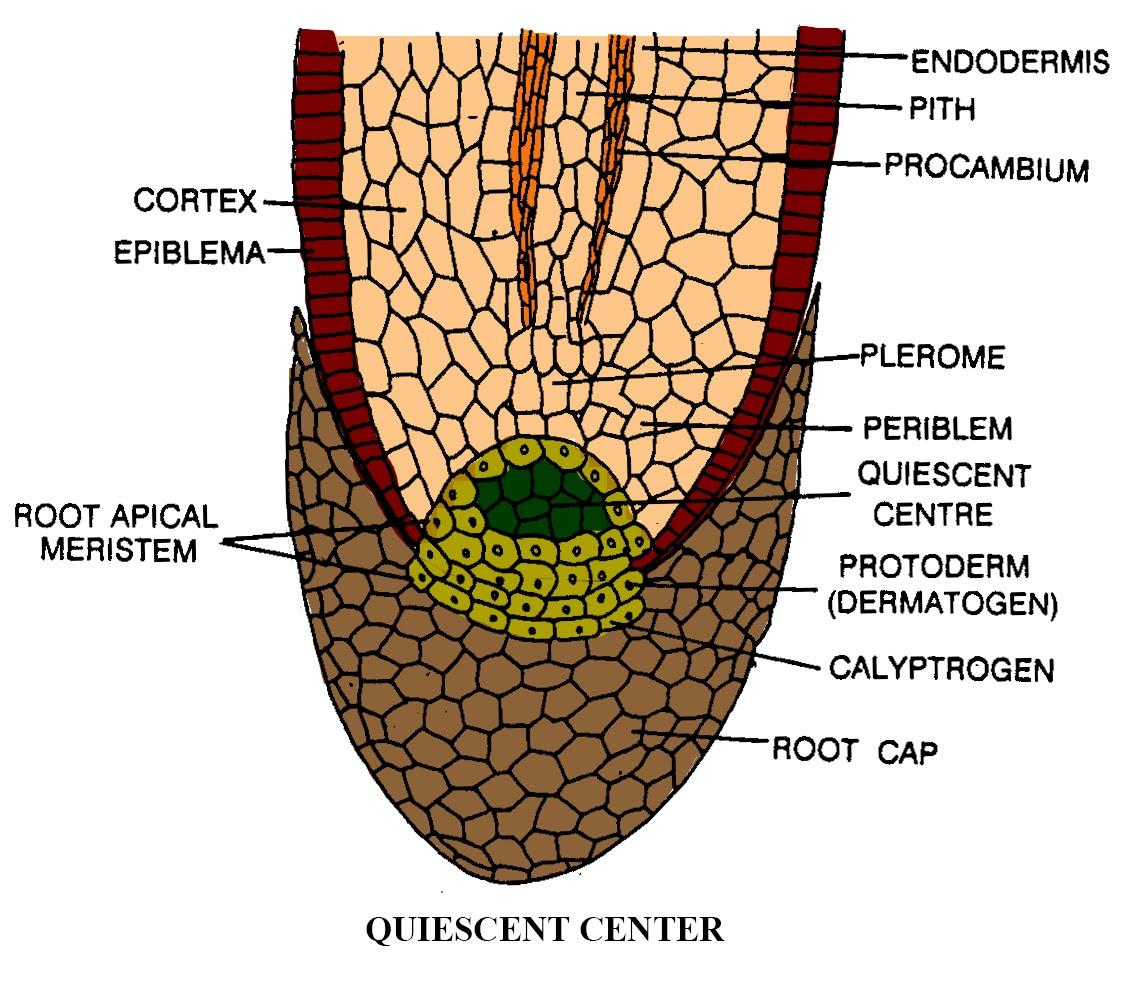
The term quiescent center (or) zone was proposed by
(a) Schmidt
(b) Foster
(c) Clowes
(d) Nageli
Answer
503.4k+ views
Hint: Growth in plants is largely restricted to a specialized region of active cell division called meristem. Plants have different kinds of meristem based on their positions and origin. A group of cells having a common origin and usually performing a common function is called a tissue. Tissues are divided into two main groups namely meristematic and permanent tissues based on whether the cells are being formed.
Complete answer:
The cells of the quiescent center are activated whenever the initials of the apical meristem are damaged. A center called quiescent center is considered to be present in root apex; this term was coined by Colwes in 1958. The root apex is comparatively short. No nodes, internodes in the root, and no branch. Primordia develops in the root apex. The root cap is present and its presence brings the root apex subterminal in position. No leaf primordia in the root apex. The quiescent center is present in the root tip. The quiescent zone is the zone of less mitotic activity in the root apex-specific region of apical meristem that produces dermal tissue, ground tissues, and vascular tissue during the formation of the primary plant body. This theory says that the root apex cells are divided into two planes. The first division is transverse and one of the daughter cells then divides longitudinally. The cells form a configuration resembling the letter T looking either straight or inverted.
Additional information:
The meristem which occurs at the tips of roots and shoots and produces primary permanent tissues is called apical meristem. The root apical meristem occupies the tip of the root covered by the root cap while the shoot apical meristem occupies the distant most region of the stem axis. During the formation of leaves and elongation of the stem, some cells left behind from the shoot apical meristem constitute the axillary bud. The axillary bud is present in the axils of leaves and is capable of forming a branch. The meristem which occurs between mature tissues is known as intercalary meristem. Whereas in the root apex the cells of the periblem are arranged in a crescent-shaped manner or disc-like or hemispherical manner are called the quiescent center or quiescent zone.
So, the correct answer is " Clowes".
Note:
Quiescent zone is the region of cells that did not display DNA synthesis 24hrs after planting including Stelar initials columella and adjacent surrounding cells. In effect, the Stelar and columella regions appear to be connected with non-DNA. DNA synthesis cells of the root cap. In the quiescent zone, the cell division proceeds very slowly but the cells are capable of resuming meristematic activity should tissue surrounding them be damaged.

The Quiescent zone in plant root
Complete answer:
The cells of the quiescent center are activated whenever the initials of the apical meristem are damaged. A center called quiescent center is considered to be present in root apex; this term was coined by Colwes in 1958. The root apex is comparatively short. No nodes, internodes in the root, and no branch. Primordia develops in the root apex. The root cap is present and its presence brings the root apex subterminal in position. No leaf primordia in the root apex. The quiescent center is present in the root tip. The quiescent zone is the zone of less mitotic activity in the root apex-specific region of apical meristem that produces dermal tissue, ground tissues, and vascular tissue during the formation of the primary plant body. This theory says that the root apex cells are divided into two planes. The first division is transverse and one of the daughter cells then divides longitudinally. The cells form a configuration resembling the letter T looking either straight or inverted.
Additional information:
The meristem which occurs at the tips of roots and shoots and produces primary permanent tissues is called apical meristem. The root apical meristem occupies the tip of the root covered by the root cap while the shoot apical meristem occupies the distant most region of the stem axis. During the formation of leaves and elongation of the stem, some cells left behind from the shoot apical meristem constitute the axillary bud. The axillary bud is present in the axils of leaves and is capable of forming a branch. The meristem which occurs between mature tissues is known as intercalary meristem. Whereas in the root apex the cells of the periblem are arranged in a crescent-shaped manner or disc-like or hemispherical manner are called the quiescent center or quiescent zone.
So, the correct answer is " Clowes".
Note:
Quiescent zone is the region of cells that did not display DNA synthesis 24hrs after planting including Stelar initials columella and adjacent surrounding cells. In effect, the Stelar and columella regions appear to be connected with non-DNA. DNA synthesis cells of the root cap. In the quiescent zone, the cell division proceeds very slowly but the cells are capable of resuming meristematic activity should tissue surrounding them be damaged.

The Quiescent zone in plant root
Recently Updated Pages
The number of solutions in x in 02pi for which sqrt class 12 maths CBSE

Write any two methods of preparation of phenol Give class 12 chemistry CBSE

Differentiate between action potential and resting class 12 biology CBSE

Two plane mirrors arranged at right angles to each class 12 physics CBSE

Which of the following molecules is are chiral A I class 12 chemistry CBSE

Name different types of neurons and give one function class 12 biology CBSE

Trending doubts
One Metric ton is equal to kg A 10000 B 1000 C 100 class 11 physics CBSE

Explain zero factorial class 11 maths CBSE

What is 1s 2s 2p 3s 3p class 11 chemistry CBSE

Discuss the various forms of bacteria class 11 biology CBSE

State the laws of reflection of light

Difference Between Prokaryotic Cells and Eukaryotic Cells




